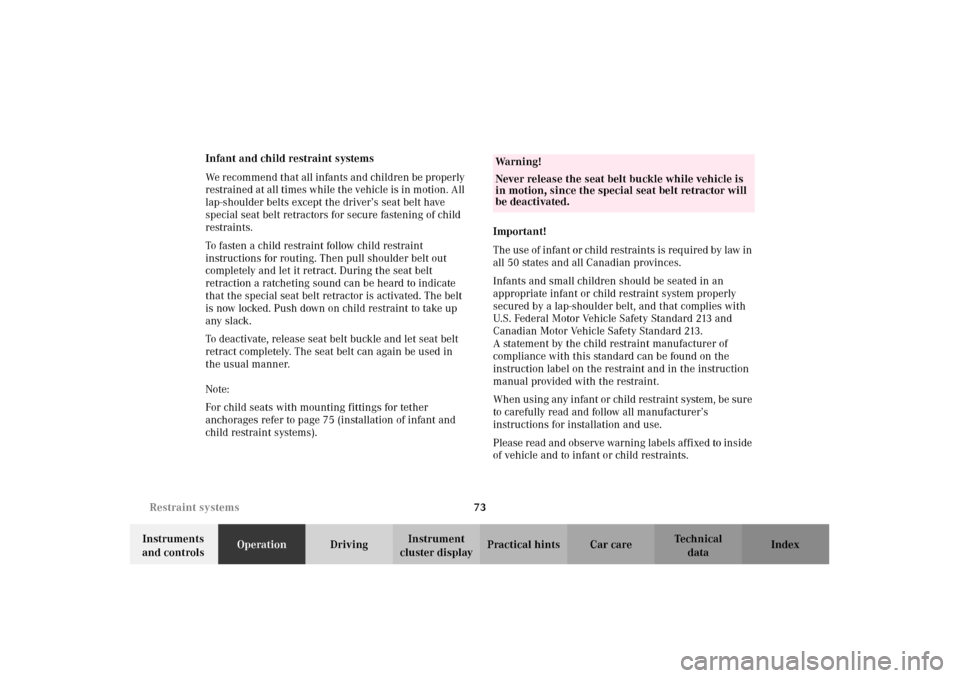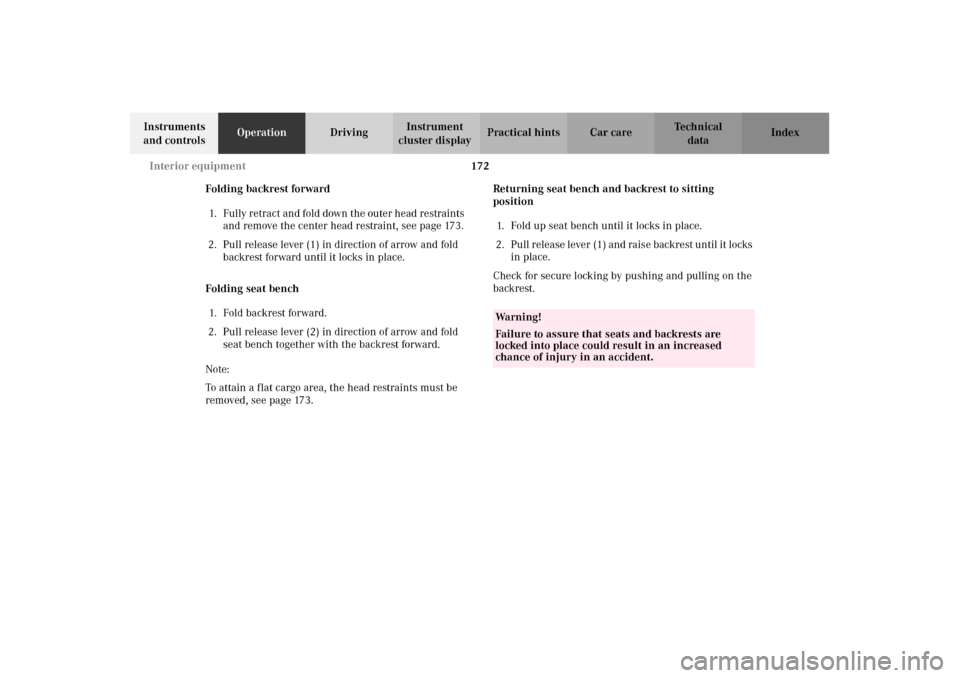Page 68 of 385

65 Restraint systems
Te ch n i c a l
data Instruments
and controlsOperationDrivingInstrument
cluster displayPractical hints Car care Index Emergency tensioning retractor (ETR)
The seat belts for the front seats and outboard
passenger seats are equipped with emergency
tensioning retractors. These tensioning retractors are
located in each seat belt buckle and become
operationally ready with the key in starter switch
position 1 or 2.
The emergency tensioning retractors are designed to
activate only when the seat belts are fastened during
frontal impacts exceeding the first threshold of the SRS
and in rear impacts exceeding a preset severity level.
They remove slack from the belts in such a way that the
seat belts fit more snugly against the body restricting its
forward movement as much as possible.
In cases of other frontal impacts, angled impacts, roll-
overs, certain side impacts, or other accidents without
sufficient frontal or rear impact forces, the emergency
tensioning retractors will not be activated. The driver
and passengers will then be protected by the fastened
seat belts and inertia reel in the usual manner.
For seat belt and emergency tensioning retractor see
page 71.Note:
The emergency tensioning retractors for the driver and
front passenger seats will only deploy if the front seat
belts are buckled.
The rear center automatic two point seat belt is not
equipped with an emergency tensioning retractor.
J_G463.book Seite 65 Mittwoch, 19. September 2001 8:06 08
Page 76 of 385

73 Restraint systems
Te ch n i c a l
data Instruments
and controlsOperationDrivingInstrument
cluster displayPractical hints Car care Index Infant and child restraint systems
We recommend that all infants and children be properly
restrained at all times while the vehicle is in motion. All
lap-shoulder belts except the driver’s seat belt have
special seat belt retractors for secure fastening of child
restraints.
To fasten a child restraint follow child restraint
instructions for routing. Then pull shoulder belt out
completely and let it retract. During the seat belt
retraction a ratcheting sound can be heard to indicate
that the special seat belt retractor is activated. The belt
is now locked. Push down on child restraint to take up
any slack.
To deactivate, release seat belt buckle and let seat belt
retract completely. The seat belt can again be used in
the usual manner.
Note:
For child seats with mounting fittings for tether
anchorages refer to page 75 (installation of infant and
child restraint systems).Important!
The use of infant or child restraints is required by law in
all 50 states and all Canadian provinces.
Infants and small children should be seated in an
appropriate infant or child restraint system properly
secured by a lap-shoulder belt, and that complies with
U.S. Federal Motor Vehicle Safety Standard 213 and
Canadian Motor Vehicle Safety Standard 213.
A statement by the child restraint manufacturer of
compliance with this standard can be found on the
instruction label on the restraint and in the instruction
manual provided with the restraint.
When using any infant or child restraint system, be sure
to carefully read and follow all manufacturer’s
instructions for installation and use.
Please read and observe warning labels affixed to inside
of vehicle and to infant or child restraints.
Wa r n i n g !
Never release the seat belt buckle while vehicle is
in motion, since the special seat belt retractor will
be deactivated.
J_G463.book Seite 73 Mittwoch, 19. September 2001 8:06 08
Page 77 of 385

74 Restraint systems
Te ch n i c a l
data Instruments
and controlsOperationDrivingInstrument
cluster displayPractical hints Car care Index
Wa r n i n g !
Children 12 years old and under must never ride in
the front seat, except in a Mercedes-Benz
authorized BabySmart
TM compatible child seat,
which operates with the BabySmart
TM System
installed in the vehicle to deactivate the passenger
front airbag when it is properly installed.
Otherwise they will be struck by the airbag when it
inflates in a crash. If this happens, serious or fatal
injury can result.
According to accident statistics, children are safer
when properly restrained in the rear seating
positions than in the front seating positions.
Infants and small children must ride in back seats
an d b e s eated in a n i nfan t or chi ld restra in t system ,
which is properly secured with the vehicle’s seat
belt, fully in accordance with the child seat
manufacturer’s instructions.Infants and small children should never share a
seat belt with another occupant. During an
accident, they could be crushed between the
occupant and seat belt.
Children too big for child restraint systems must
ride in back seats using regular seat belts. Position
shoulder belt across chest and shoulder, not face or
neck. A booster seat may be necessary to achieve
proper belt positioning for children from 41 lbs. to
the point where a lap / shoulder belt fits properly
without one.When the child restraint is not in use, remove it
from the vehicle or secure it with the seat belt to
prevent the child restraint from becoming a
projectile in the event of an accident.Do not leave children unattended in the vehicle;
even if the children are secured in a child restraint
system. Unsupervised children in a child restraint
system may use vehicle equipment and may cause
serious personal injury.
J_G463.book Seite 74 Mittwoch, 19. September 2001 8:06 08
Page 78 of 385
75 Restraint systems
Te ch n i c a l
data Instruments
and controlsOperationDrivingInstrument
cluster displayPractical hints Car care Index Installation of infant and child restraint systems
The anchorage rings (1) are located in the rear cargo
compartment. Located on each side of the passenger
compartment are two anchorage rings (for the rear outer
seats) and one on the roof pillar above the tailgate (for
the rear center seat).
Guide tether strap between head restraints. Be carefully
that the tether strap is not twisted.
When mounting a tether strap on the rear outer seats,
reinstall the cargo area cover blind (page 180) and the
optional partition net (page 175).To secure a tether strap to the anchorage, securely
fasten the hook (3), which is part of the tether strap, to
the anchorage ring (2). For safety, please make sure that
the hook has attached to the ring beyond the safety
catch, as illustrated.
1
1
1
1
1
J_G463.book Seite 75 Mittwoch, 19. September 2001 8:06 08
Page 79 of 385
76 Restraint systems
Te ch n i c a l
data Instruments
and controlsOperationDrivingInstrument
cluster displayPractical hints Car care Index
Child seat mounts – “LATCH” type
This vehicle is provided with two “LATCH” type mounts
(at each of the outer rear seats) for the installation of a
“LATCH” child seat having the matching mounting
fittings.Install child seat according to the manufacturer’s
instructions.
The child seat must be firmly attached in the right and
left side mounting fittings (1).
Non-“LATCH” type child seats may also be used and are
capable of being installed using the vehicle’s seat belt
system. Install child seat according to the
manufacturer’s instructions.
Note:
With a child seat installed in the left rear seat, the seat
belt for the center seat occupied by a passenger must
operate freely.
1
1
J_G463.book Seite 76 Mittwoch, 19. September 2001 8:06 08
Page 80 of 385

77 Restraint systems
Te ch n i c a l
data Instruments
and controlsOperationDrivingInstrument
cluster displayPractical hints Car care Index
Wa r n i n g !
The “LATCH” mounting fittings are intended for
children up to 50 lbs (22 kg) in weight.Children too big for child restraint systems must
ride in back seats using regular seat belts. Position
shoulder belt across chest and shoulder, not face or
neck. A booster seat may be necessary to achieve
proper belt positioning for children from 41 lbs. to
the point where a lap / shoulder belt fits properly
without one.Install child seat according to manufacturer’s
instructions.
The child seat must be firmly attached in the right
and left side mounting fittings (1).An incorrectly mounted child seat may come loose
during an accident.Damaged or impact damaged child seats or child
seat mounting fittings must be replaced.Do not leave children unattended in the vehicle,
even if the children are secured in a child restraint
system.
J_G463.book Seite 77 Mittwoch, 19. September 2001 8:06 08
Page 174 of 385

171 Interior equipment
Te ch n i c a l
data Instruments
and controlsOperationDrivingInstrument
cluster displayPractical hints Car care Index Split rear seat bench
1Lever for seat backrest sections
2Lever for seat bench sections
The rear seat bench can be folded and lowered to
increase the cargo area. The left, right or both seat
backrests sections may folded down according to need.Important!
Only drive with the tailgate closed as otherwise exhaust
fumes may enter the vehicle interior.
Note:
Before folding the backrest forward and the rear seat
bench down, be sure that all containers in the rear cup
holder are removed.
1
2
2
1
Wa r n i n g !
Failure to assure that seats and backrests are
locked into place could result in an increased
chance of injury in an accident.Never place hands under seat or near any moving
parts while a seat is being adjusted.For safety reasons the rear seat bench must only be
adjusted when the vehicle is stationary.
J_G463.book Seite 171 Mittwoch, 19. September 2001 8:06 08
Page 175 of 385

172 Interior equipment
Te ch n i c a l
data Instruments
and controlsOperationDrivingInstrument
cluster displayPractical hints Car care Index
Folding backrest forward
1. Fully retract and fold down the outer head restraints
and remove the center head restraint, see page 173.
2. Pull release lever (1) in direction of arrow and fold
backrest forward until it locks in place.
Folding seat bench
1. Fold backrest forward.
2. Pull release lever (2) in direction of arrow and fold
seat bench together with the backrest forward.
Note:
To attain a flat cargo area, the head restraints must be
removed, see page 173.Returning seat bench and backrest to sitting
position
1. Fold up seat bench until it locks in place.
2. Pull release lever (1) and raise backrest until it locks
in place.
Check for secure locking by pushing and pulling on the
backrest.
Wa r n i n g !
Failure to assure that seats and backrests are
locked into place could result in an increased
chance of injury in an accident.
J_G463.book Seite 172 Mittwoch, 19. September 2001 8:06 08